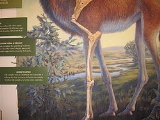
Megatylopus
Encyclopedia
Megatylopus is an extinct and large genus of terrestrial
herbivore
the family
Camelidae, endemic to North America
from the Miocene
through Late Pliocene—Early Pleistocene
boundary 13.6—1.8 mya, existing for approximately .
remains have been found in Oklahoma
, USA.
Terrestrial animal
Terrestrial animals are animals that live predominantly or entirely on land , as compared with aquatic animals, which live predominantly or entirely in the water , or amphibians, which rely on a combination of aquatic and terrestrial habitats...
herbivore
Herbivore
Herbivores are organisms that are anatomically and physiologically adapted to eat plant-based foods. Herbivory is a form of consumption in which an organism principally eats autotrophs such as plants, algae and photosynthesizing bacteria. More generally, organisms that feed on autotrophs in...
the family
Family (biology)
In biological classification, family is* a taxonomic rank. Other well-known ranks are life, domain, kingdom, phylum, class, order, genus, and species, with family fitting between order and genus. As for the other well-known ranks, there is the option of an immediately lower rank, indicated by the...
Camelidae, endemic to North America
North America
North America is a continent wholly within the Northern Hemisphere and almost wholly within the Western Hemisphere. It is also considered a northern subcontinent of the Americas...
from the Miocene
Miocene
The Miocene is a geological epoch of the Neogene Period and extends from about . The Miocene was named by Sir Charles Lyell. Its name comes from the Greek words and and means "less recent" because it has 18% fewer modern sea invertebrates than the Pliocene. The Miocene follows the Oligocene...
through Late Pliocene—Early Pleistocene
Early Pleistocene
Calabrian is a subdivision of the Pleistocene Epoch of the Geologic time scale. ~1.8 Ma.—781,000 years ago ± 5,000 years, a period of ~.The end of the stage is defined by the last magnetic pole reversal and plunge in to an ice age and global drying possibly colder and drier than the late Miocene ...
boundary 13.6—1.8 mya, existing for approximately .
Taxonomy
Megatylopus was named by Matthew and Cook (1909). Its type is Megatylopus gigas. It was synonymized subjectively with Paracamelus by Macdonald (1959). It was assigned to Camelidae by Matthew and Cook (1909), Webb (1965), Patton (1969), Harrison (1985), Carroll (1988) and Honey et al. (1998).Morphology
It stood about 4,20 m (14 ft) tall, with its legs already measuring 2,10 m (7 ft). FossilFossil
Fossils are the preserved remains or traces of animals , plants, and other organisms from the remote past...
remains have been found in Oklahoma
Oklahoma
Oklahoma is a state located in the South Central region of the United States of America. With an estimated 3,751,351 residents as of the 2010 census and a land area of 68,667 square miles , Oklahoma is the 28th most populous and 20th-largest state...
, USA.

